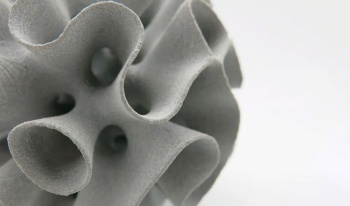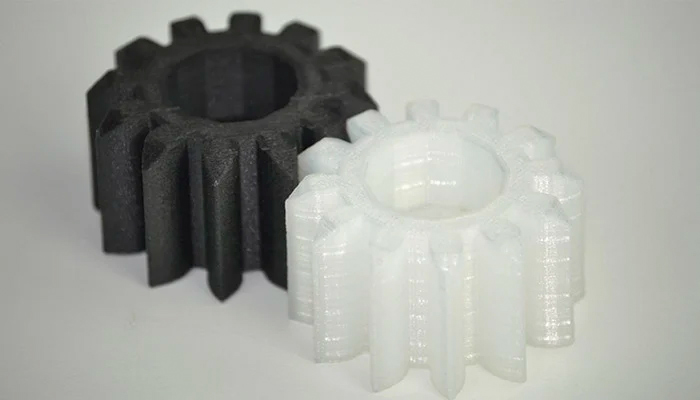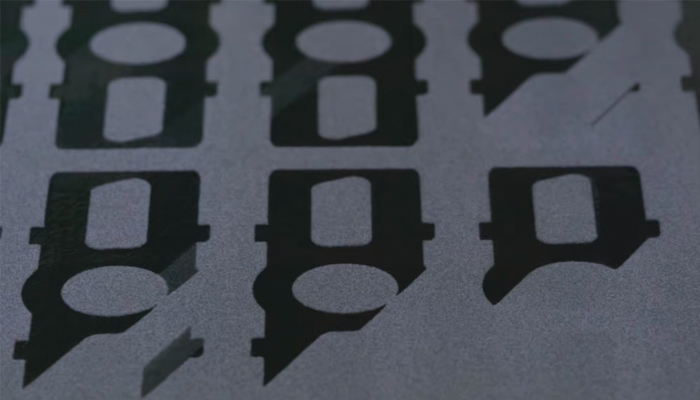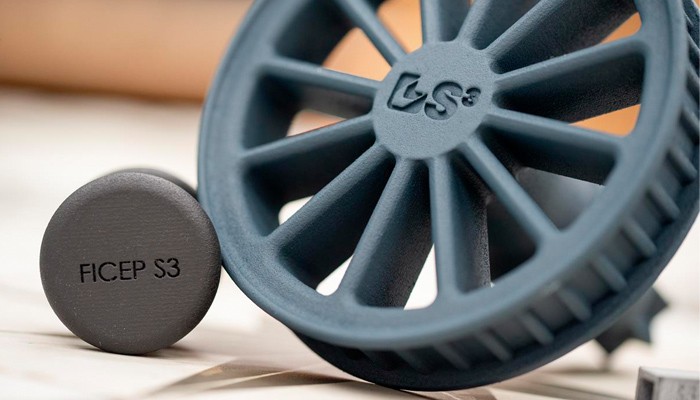
Nylon, as we already know, is a synthetic polymer belonging to the polyamide (PA) group. In additive manufacturing, we can find it in filament form (PA6) for FDM technology, or in powder form (PA11 and PA12) for technologies such as selective laser sintering or HP’s MultiJet Fusion. Despite being a highly utilized material in the 3D printing industry, nylon has been the subject of debate at times, especially as concerns its sustainability. This is due to several factors, such as the composition of some polyamides, the degree of recyclability and reusability of the material, or gas emissions during the manufacturing process. In addition, commitment to the environment is an aspect that all companies are taking and must take into consideration nowadays, something that we will also see later on.
If we focus only on nylon 3D printing, it is clear that, depending on the type of polyamide, its origin and composition, this material will have a greater or lesser impact on the environment. To better understand its role in the industry, as well as its carbon footprint, we will try to analyze the characteristics and properties of nylon, both in powder and filament form. So how are PA6 filaments printed, how do PA11 and PA12 differ, where does the 3D industry stand in terms of nylon usage and sustainability, and are there viable alternatives? Below, we will provide answers to all of these in order to understand more about how sustainable this material is and the way forward for the manufacturing industry.

Photo Credits: FICEP S3
PA6, a demanding 3D printing filament
PA6 filament is a semi-crystalline thermoplastic polymer and is one of the most widely used polyamides worldwide. With a melting point of 220°C, PA6 is used in a wide variety of applications due to its good performance/cost ratio. Although it has traditionally been used in industrial manufacturing methods, it has gradually gained popularity in the 3D printing sector because of its interesting mechanical properties and its ability to create high-performance parts. In addition, PA6 is a much more difficult material to 3D print when compared to standard plastics such as PLA or ABS. Its operating temperature range is 250-270°C, so a suitable working environment must be ensured so that it does not shrink.
As for its origin, we can say that it differs from other types of polyamides in that it is formed by ring-opening polymerization, i.e., by one of the routes by which many polymers are synthesized. This makes it a special case in the comparison between condensation (the entire monomer molecule becomes part of the polymer) and addition (part of the monomer molecule is lost when it becomes part of the polymer) polymers. When analyzing the environmental impact of polyamide 6 and moving towards a more sustainable material, two important aspects must be taken into account. Firstly, the production processes used to obtain the material, and secondly, the raw material involved in this conversion process; both will define the carbon footprint of this polyamide.

PA6 is a demanding 3D printing filament (photo credits: Sharebot)
Composition and environmental impact of PA11 and PA12
In chemical terms, polyamides 11 and 12 are very similar, although they differ only by one carbon atom in the polymer’s main chain. However, that single atom makes a huge difference in the way the polymer is organized to create matter. Other than that, the main differences between polyamide powders for 3D printing lie in their provenance. On the one hand, PA11 is a semi-crystalline polymer that is generated from a “green” feedstock in a synthesis process closer to PA6 than PA12. This type of nylon is bio-based, i.e. it is produced from renewable raw materials derived from vegetable derivatives, mostly castor oil. With regard to its applications, polyamide 11 is mainly found where good chemical resistance, flexibility, low permeability and dimensional stability are required. That is, in aggressive environments and functional prototypes that are exposed to these conditions.
On the other hand, PA12 is a fine synthetic powder that is generally derived from petroleum. Its basic characteristics are given by the chemical structure of the polyamide itself, as well as the addition of additives or fibers that are added to the composition. Its most important properties are high resistance to chemical agents, environmental conditions and impact, as well as low water absorption, high processability and, finally, good resistance to abrasion and sliding. Among its main applications, this plastic is used in advanced industries, such as automotive or aeronautics. As we have mentioned, this is due to its excellent mechanical properties, which are key in this type of professional sectors.
While discussing its own PA11 HP, Sculpteo illustrates the disparities between the two polyamides and, more specifically, their relationship to sustainable sources, with the website stating: “Our PA11 HP is based on 100% renewable biomass sources. The Castor seed is extracted from the castor plant to make oil. The oil is then converted into the monomer (11-aminoundecanoic acid), which is finally polymerized into the Polyamide 11. This PA11 material is a sustainable alternative to PA12, offering interesting properties for your components requiring skin contact.” That shows that in terms of sustainability, nylon 11 should be the bioplastic to turn to first, although the applications of the final 3D printed parts also need to be taken into consideration.

Photo Credits: Formlabs
Given the properties of both polyamides, bioplastic might seem, at first glance, to be a better alternative to conventional plastic, since it is made in part from renewable resources and can be biodegradable. However, Nuno Neves, head of design at FICEP S3, told us: “To determine whether bioplastic is better for our environment when compared to conventional plastic, we must consider several factors across the entire lifecycle of conventional plastics versus bioplastics, including production, greenhouse gas emissions and recycling opportunities. Something we at FICEP S3 do with every material we use and every product we design. We make decisions based on data and the scientific reality of a given situation, beyond wanting to jump on an eco-friendly bandwagon.” That said, and taking into account the properties of nylon, let’s look at its use in 3D printing as well as its relationship in terms of sustainability.
Nylon, 3D printing and sustainability
As with other synthetic plastics, nylon is not a material that can be degraded by the environment. This would be the case with other natural resources, such as paper, wood or glass, which oxidize and decompose over time. Therefore, the most recurrent method to combat the complex disposal of plastics on our planet is recycling, i.e. its transformation. One aspect to keep in mind is that bioplastics, such as PA11, are difficult to recycle, as most cities do not have the facilities required for this type of transformation. Many of them end up in landfills, which causes them to be deprived of oxygen. This triggers the release of methane into the atmosphere, a greenhouse gas that is 23 times stronger than CO2, which would contribute to greater ozone depletion than with traditional plastics.
Focusing on the two main technologies used, we note that, in terms of sustainability, nylon SLS 3D printing has a key advantage. Once the manufacturing process is complete, the parts are surrounded by unsintered powder, which in turn acts as a support for the printed parts. In SLS technology, up to 70% of this unsintered powder can be reused for future printing. From a sustainability and recyclability point of view, this is a major advantage over the FDM method, as the support materials that are printed are not able to be converted for reuse.

In SLS technology, up to 70% of the unsintered powder can be reused (photo credits: Arkema)
In order to evaluate and control the environmental impact of companies, there is the so-called CSR or Corporate Social Responsibility, which refers to the responsibility that each organization has towards the environment. This aspect is increasingly present in the activity of all 3D printing players. In fact, many companies in the industry are already developing bio-based solutions to reduce this environmental impact.
Arkema is one of the most renowned chemists in the industry and has a wide range of materials for additive manufacturing, including nylon. In particular, the company has unique expertise and know-how in castor plant chemistry. From this plant, a wide range of high-performance long-chain biodegradable polyamides can be developed, as is the case with the company’s Rilsan® polyamide 11 range. Jean-Luc-Dubois, Director of Catalysis, Process and Biomass Conversion at Arkema, commented, “Our bio-based processes demonstrate that you can use renewable feedstocks to manufacture technical and cost-competitive products that meet real market demand.”
Future outlook for nylon in terms of sustainability
It is clear that all manufacturing materials used in the manufacturing industry have some impact on the environment, either through the emission of gases or the degree of recyclability of the parts. In addition, while there is currently no viable replacement for petroleum-based polyamide, very promising bio-based polyamide building blocks are currently being investigated. As the price of oil continues to fluctuate and awareness of the climate crisis increases, it is likely that more alternatives to current nylon components will be developed.

The additive manufacturing industry has a promising future in terms of sustainability (photo credits: FICEP S3)
Still, focusing on the 3D printing process itself, we know that the technology is known to reduce manufacturing times and the amount of material used. Regarding the use of polyamide 11, the Arkema team states on its website: “More and more companies are demanding clean and sustainable materials. PA11 is a 100% bio-based polymer and selecting it fits perfectly with this green strategy to help achieve corporate social responsibility goals.” Regarding the global use of nylon, Nuno Neves of FICEP S3 gives us a more contrasting view: “The solution is not to stop manufacturing and using petroleum-based plastics, but to use them in a smarter way, recycle them correctly, and stop thinking that everything ‘bio’ is synonymous with good, which is rarely that simple”.
Contrasting both views, it is clear that the additive manufacturing industry is on the right track when it comes to the use of nylon. However, there is still a long way to go to make, as Neves says, the “bio” positive and achieve more sustainable manufacturing with less environmental impact.
*Cover Photo Credits: Sculpteo



